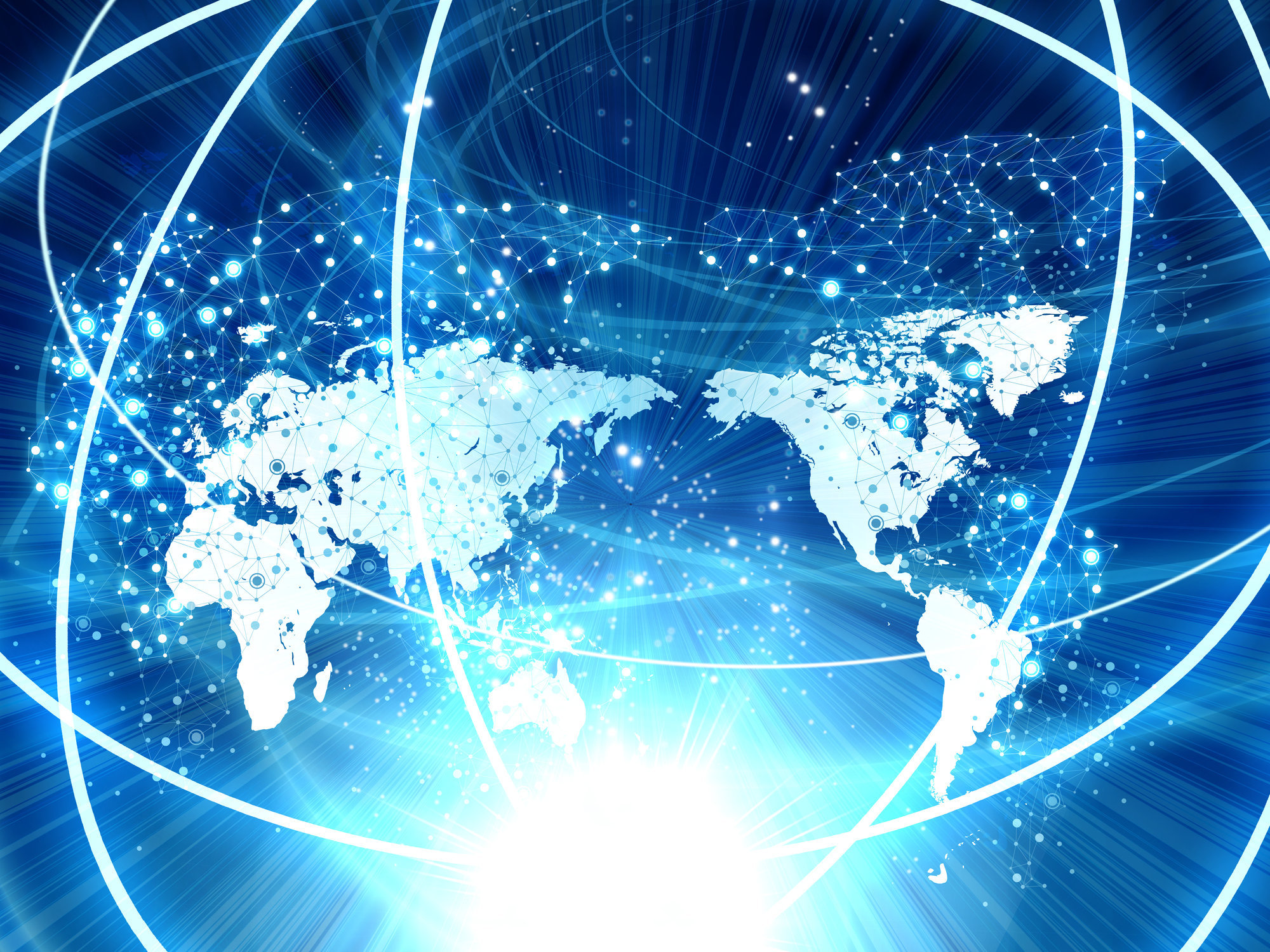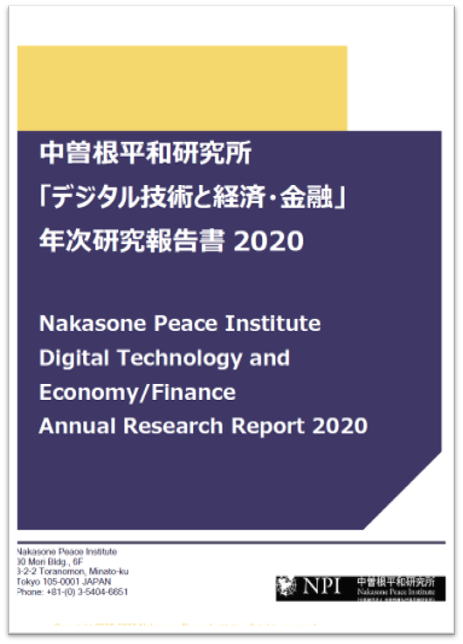2020/08/07
" The New ICT R&D Strategy for Japan in the 2020s " ("Digital Technology and Economy/Finance" Study Group)
The Nakasone Peace Institute held the web conference on "The New ICT R&D Strategy for Japan in the 2020s" with Mr. Tohru Asami (President, Advanced Telecommunications Research Institute International (ATR)) and other regular members, on July 27th 2020.
1 Presentation " The New ICT R&D Strategy for Japan in the 2020s " (Mr. Asami)
■Key Points in "The State of the New Information and Communications Technology Strategy" by MIC of Japan
Ministry of Internal Affairs and Communications recently asked for public comment "New Information and Communication Technology Strategy" (4th Interim Report (Draft)) https://www.soumu.go.jp/main_content/000688902.pdf). As a person involved in the work of, I would like to look at the new ICT technology strategy for the next 10 years while touching on its contents.
In this report (including past reports), some of the points of particular importance are "Quantum Technology Innovation Strategy," "Global ICT Strategy," "Priority R&D Fields and IoT Promotion Structure," and "Human Resources for the IoT/BD (Big Data) / AI (Artificial Intelligence) Era".
In addition to nurturing advanced technologies such as quantum technologies domestically, it also considers the overall ICT R&D strategy not only for international cooperation but also for the resolution of social issues, and forms a team of "producers," "innovators," "service developers," and "engineers" to realize these strategies, with attention to technical, geographical, social, and human resource expansion.
■The Importance of two types of SOUZOU: 'Creation' and 'Imagination'
Human resources are especially important when it comes to driving innovation. Of the four types of human resources mentioned above, the second "innovator" human resource is a little weak in Japan. In the next 10 years, ICT innovations will combine various technologies with data from user companies, brain information, language processing data, and space data, among others. At such times, two types of creativity are particularly important.
The first is "creation". The other is "imagination". The latter is particularly important in terms of creating an image for the development of groundbreaking services that can generate innovation.
■The Japan's lost 20 years of ICT - Innovation in personal services is progressing, but what about in business and government? ~
The 'e-Japan' strategy of 2001 was the starting point of ICT technological & social strategy in the Internet age in Japan. However, although personal service innovation has advanced in the last 20 years, it cannot be said that ICT innovation in companies and governments is halfway.
The two major technological advances in the past 20 years have been in the areas of "computer (server) virtualization technology" and "high-speed communication network technology". The former is a qualitative innovation that is centered on the U.S., and the latter is a quantitative innovation in which Japan has led the world, especially in the field of optical communications. However, cloud services that combine both of these technologies have been dominated by the US.
And, as represented by GAFA, the cloud service spreads ahead of individuals, and its introduction to companies and governments in Japan has only just begun or is still in the middle. This is largely due to the fact that companies and governments have become accustomed to the "tailor-made" system that was developed specifically for each of them.
■What are the innovation requirements for the 5G and beyond?
There are three keywords in the strategic area of the Beyond 5G: "ultra-high speed", "ultra-low latency", and "ultra-large number of simultaneous connections". These do not necessarily compete for superiority in performance between countries. Rather, they are common goals, given the characteristics of communications such as interconnectivity and interoperability.
The 5G and Beyond 5G are expected to be utilized as flexible IoT in the production process (inspection/monitoring/control) of factories or automatic driving (accident prevention) as IoT. These require extremely short response times of 0.1 or 0.01 seconds or less. The response time includes not only the communication speed but also the time required for image processing and network processing, and the smooth linkage with the operation of production robots and car control is also essential.
In developing such technology, in order to realize the tight conditions as a series of flows, it is essential to innovate with people who plan and utilize actual services. It is through this process that we will be able to reach the research and development of truly necessary elemental technologies.
■"Standardization" and "Political Leadership" are the keys to social implementation of ICT technology
The COVID-19 has exposed the differences in the social implementation of ICT technology in different countries around the world. The technology used itself is simple and easy. However, the social implementation of the ICT technology in each country depends on whether standardizing or not of "the related software tools", "the related work flows", "the related job descriptions" and "the personal data protection system".
Japan has to learn the importance of these things from the numerous cases this time, such as the paying of benefits and the capturing of infected persons. It should be remembered that many East Asian countries were able to utilize them better than Japan.
Electronic and online medical records are now at a high level in Japan, but the related technology itself has been studied for about 50 years. For many years, however, this technology was not institutionalized, and even after its institutionalization around 2000, its penetration rate remained low. However, what influenced this social implementation was the strong leadership of then Prime Minister Koizumi in 2005. Thus, also we should not forget that political leadership is important to accelerate social implementation.
■The requirements for a data distribution platform as a source of value creation in the digital age
Electronic commerce on the Internet has become a global business, not to mention advertising on the Internet. It is not uncommon for advertisers, ad agencies, and the servers on the cloud services where they are located to be located outside of Japan and in different countries.
Under these circumstances, it is doubtful that there will be a system in which the source country/source business of value generation as an advertisement is identified and appropriate taxation is made there.
Anonymity is a major premise of current Internet technology. "HTTPS" (Hypertext Transfer Protocol Secure), which is most used as a certain security for browsing homepages including Internet commerce, confirms data exchange unless it is a transaction between a well-meaning user and a well-meaning operator. It is extremely difficult to specify the receiving place.
Of course, there are several ways to solve this technically. However, whether or not they will be accepted by the countries and companies involved and whether or not they will be implemented in society is another matter. It may be possible to take a leadership role in this regard, for example, by first demonstrating the technology domestically in Japan, and then verifying and deploying it jointly with other countries in line with the progress of the project.
2 Discussion
■Main issue 1: The Opportunities for Japan in the 5G/Beyond5G Era (Tech-side Strategy)
○Regarding mobile, IoT, and data utilization, the best approach is to build a service model that successfully combines edge computing based on not only technology but also legal systems and the mobility of data, not only for domestic but also in collaboration with the EU and other countries.
○In the field of quantum related technologies, Japan is the world's leader in quantum computing, quantum information and communication, and optical (photonic) networks, with a high level of research. However, the problem does not end there; the question is how to combine these elemental technologies and grow the business on a larger scale.
○Furthermore, the terahertz wave technology, which is even higher than the frequency band currently used, has been developed. Although terahertz wave technology is so high-frequency that it is outside the scope of the Japan's Radio Law, it can be used for sensing and diagnosis as well as wireless communication. It is important to aggressively pursue research and development of technologies that can provide such functionality, with reviewing the legal system.
○In addition, the competence and know-how that Japanese companies had in the past were and are still important (e.g. cloud business based on data centers, technology in mobile terminal hardware and software, etc.). It is necessary to creatively identify and refine global strengths based on a review of these strengths.
○Regarding the intellectual property strategy, the current mainstream approach is to patent only the core product technology, which is exclusive and black box, and to open, share and standardize all the connection specifications to enable interchangeable incorporation into various devices and services. This is so called "The Open and Close Strategy", which would be essential for the next 10 years.
■Main issue 2: The Opportunities for Japan in the 5G/Beyond5G Era (Organization and Human Resource Strategy)
○Regarding international collaboration. Japan, the United States, and Europe have a long history of technological development cooperation. In particular, there is a history of working with European people in the process of standardization. We should make the most of these things.
○Domestically, new innovations and new social value creation will not be realized unless political leadership and inter-ministerial cooperation are established at the national level.
○Also, it is necessary to evaluate the policies after they have been implemented. The e-Japan strategy in 2001 has not yet been sufficiently reviewed. Japan will not be able to become a leading country in the field of e-government unless there is a proper review of e-government and e-municipalities, including the discussion on the personal information protection.
○In order for project managers to acquire the structure and human resources to manage projects from a strategic point of view, as the U.S. Defense Advanced Research Projects Agency (DARPA) and others have done, Japan's ICT technology development needs to stimulate exchanges between people from different fields and backgrounds. Long-term retention of personnel in the same place and role is no good strategy.
○The key to innovation, one of the two "SOUZOU" initiatives, Imagination, is difficult to achieve by the government alone; one idea is to create the momentum for imaginative people to realize on their own ventures launching. Another idea is the expectation for major ICT companies which have both the business units with actual customers and the R&D department. In any case, it is important to understand the movements of customers and to evaluate R&D seeds based on that understanding.
■Main issue 3: Improving the Domestic Implementation of ICT Technology as a Basis for Seizing International Opportunities
○It is necessary to implement both simple and advanced technologies as infrastructure that can be used by companies and government agencies in their daily operations. (It does not work well if it is utilized in an emergency only.)
○In the era of 5G/Beyond 5G, new ICT technologies can only be implemented in society when both policies and technologies are in place. Therefore, it is important to take a fresh look at the design of ICT systems in conjunction with social and administrative systems.
○Most Japanese system development is tailor-made for specific customers. For the sake of universality, applicability and flexibility, it is essential to develop a system that can be used in combination with "ready-made" standard components, as is the case in Europe, the U.S. and Asia.
○The standardization of software tools, workflows, and job descriptions should be discussed in conjunction with the current reform of the way of working (which is a natural assumption in the US and Europe). If this standardization does not progress, the mobility of workers will not increase and the choice and diversification of work-life balance will not expand.
○Regarding the so-called digital divide, the following two perspectives are necessary. (1) From an age perspective, the number of seniors who can use smartphones is increasing; in the coming 10 years, almost all of them will be able to do so. We need a realistic strategy for the use of digital technology, based on the assumptions of this time frame. (2) From a regional perspective, the number of tools and services that can be used anywhere is steadily increasing, thanks to the standardization of technologies such as the spread of the cloud. Therefore, the current challenge is to turn the steady collection of regional data into big data with using such tools and services.





